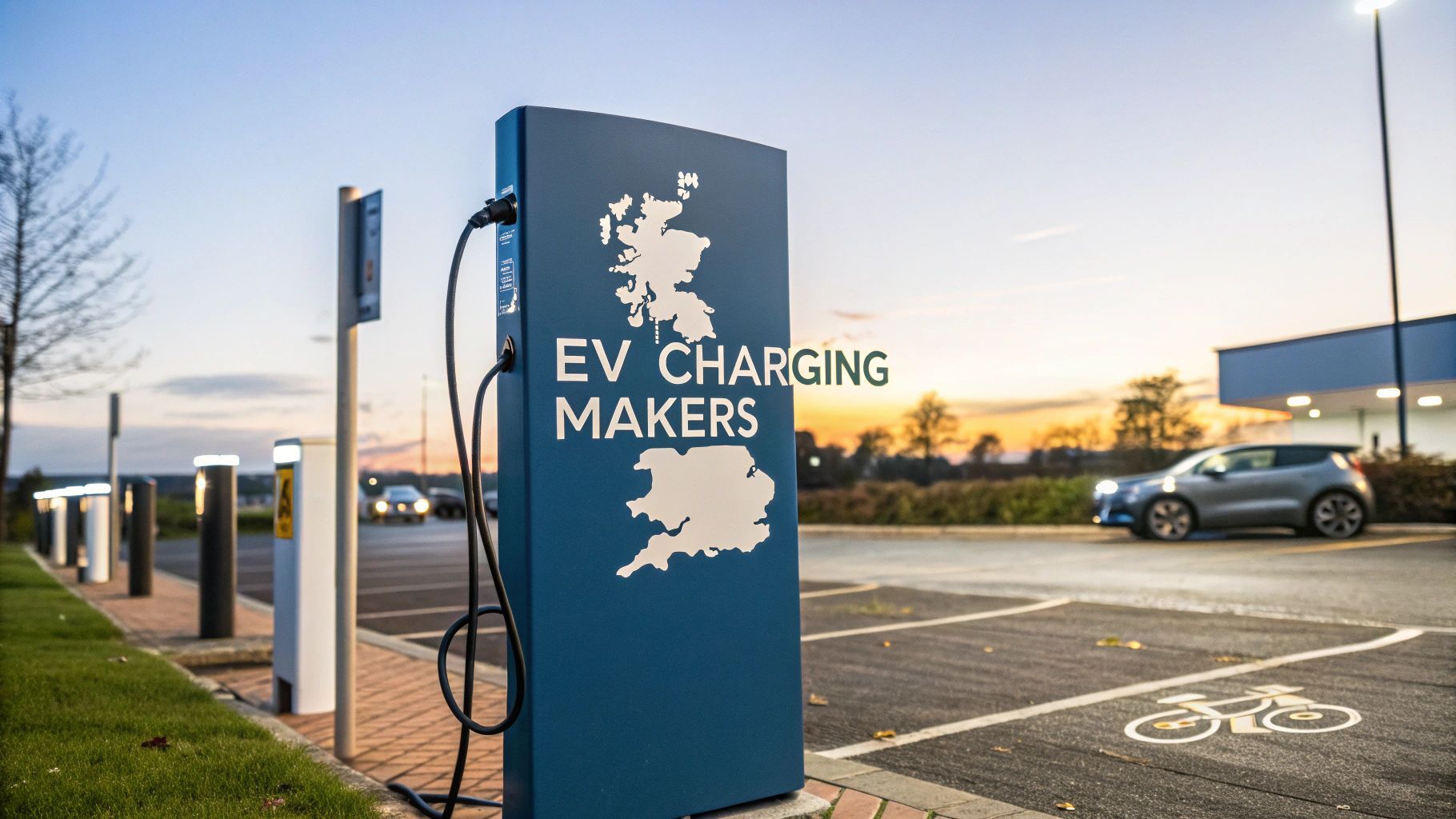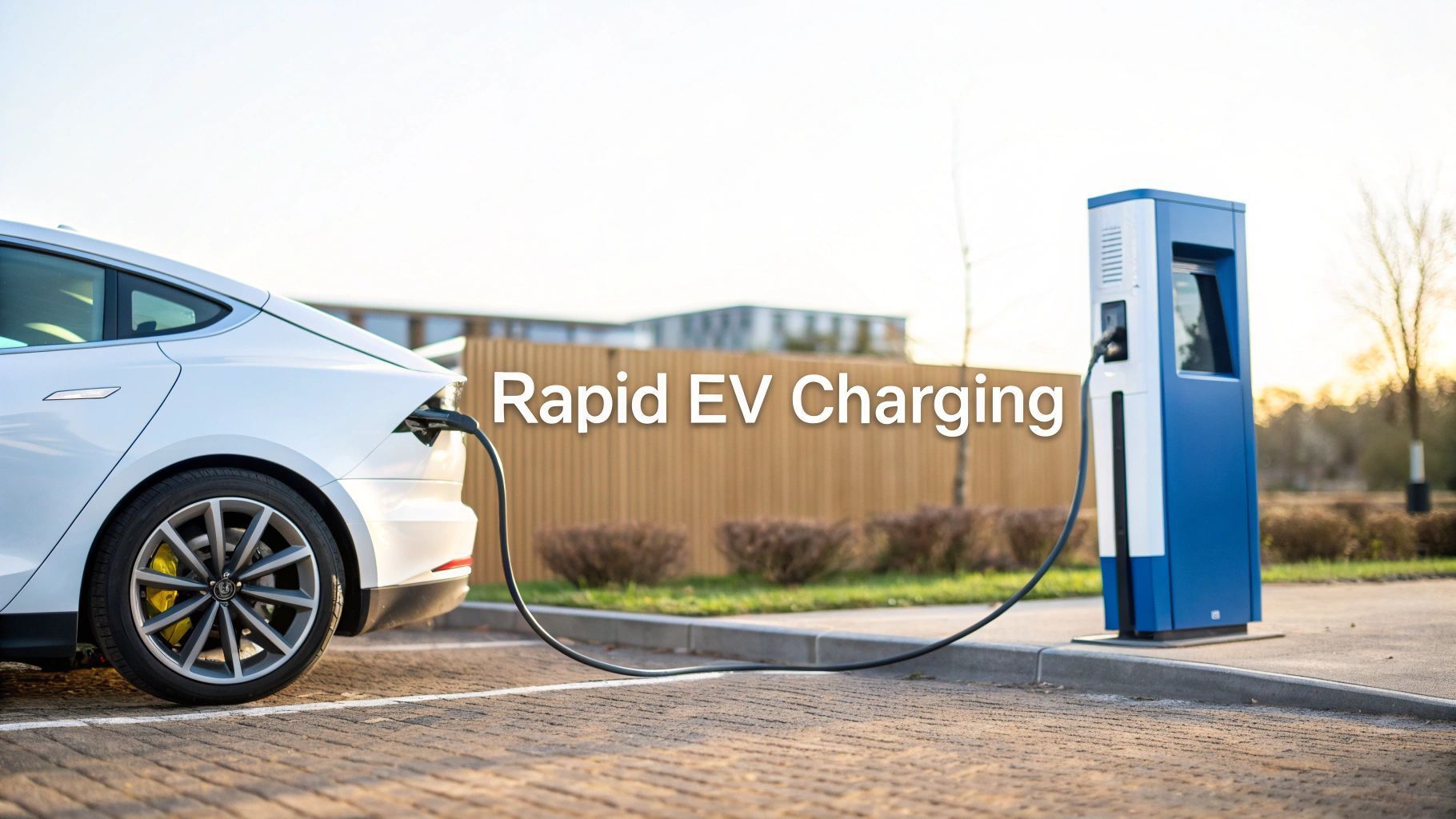UK Energy Storage Solutions Explained
Battery energy storage solutions (BESS) are the crucial shock absorbers for our national grid. They work by capturing surplus energy when generation is high and releasing it when demand peaks. This simple idea is now absolutely essential for managing the intermittent nature of wind and solar not to mention supporting the colossal power demands of rapid electric vehicle (EV) charging.
Why Energy Storage Is Reshaping the UK Power Grid
Picture the UK's National Grid as a complex network of motorways. For decades the traffic flow was pretty predictable. Power stations sent a steady stream of energy down the lanes to towns and cities. Now renewables like wind and solar are creating unpredictable bursts of traffic while the explosive growth of EVs adds thousands of new cars all needing to refuel at once. The system is under immense pressure risking gridlock and instability.
This is where energy storage particularly grid-scale batteries comes in. They act as a highly sophisticated traffic management system for the grid. Think of them as smart lay-bys and reservoirs for the energy world ensuring everything stays balanced and resilient.
A Reservoir for the National Grid
The idea behind a Battery Energy Storage System (BESS) is brilliantly simple. Imagine a huge reservoir collecting rainwater on a stormy day. A BESS does the exact same thing with electricity capturing surplus power generated on sunny or windy days when it isn't needed.
None of that energy goes to waste. It's held in reserve ready to be pushed back into the grid in milliseconds when demand spikes—like during the evening rush or when a cloud suddenly covers a solar farm.
By providing this balancing service energy storage solutions are no longer just an optional extra but a fundamental component for the UK's energy security and its transition towards a decarbonised future.
This capability is what makes integrating renewables on a massive scale possible. Without storage the grid would buckle under the fluctuating output of wind and solar farms. With it we can smooth out the peaks and troughs to create a reliable stable power supply built on clean energy. You can learn more about how ZPN's energy solutions support grid stability and resilience on our blog.
Unlocking Rapid EV Charging Everywhere
This balancing act also solves another huge national challenge: the rollout of rapid EV charging . Countless commercial sites from retail parks to logistics depots are held back by weak or constrained grid connections that simply can't handle the power draw of multiple rapid chargers. For a long time the only answer was a costly and painfully slow grid upgrade.
Battery storage completely changes the game. By combining on-site renewables with EV charging and batteries businesses can effectively create their own powerful distributed energy systems. The benefits are immediate:
- Overcoming Grid Limitations: A BESS can deliver the intense burst of power needed for rapid charging from constrained grid connections. It does this by trickling energy from the grid during cheap off-peak hours (or from on-site solar) then discharging it in a powerful flood when cars plug in.
- Battery Boosted EV Charging: EV charging units powered by internal batteries can be deployed anywhere from fleet depots to public events without needing any grid connection whatsoever if needed.
- Reducing Operational Costs: Storing cheap off-peak electricity and using it during expensive peak times massively cuts energy bills for any business operating chargers.
Understanding Grid-Scale Batteries and BESS Technology

To really get to grips with modern energy storage we need to look under the bonnet at the technology making it all possible. The heart of this revolution is the Battery Energy Storage System or BESS. This isn't just a big battery; it's a sophisticated fully integrated system designed to absorb store and dispatch electricity with incredible precision.
Think of a BESS as the brain and heart of a local energy network. It intelligently manages the flow of power ensuring stability for everything from a hub of rapid EV chargers to an entire commercial building. This level of control is what turns a simple battery into a powerful grid-balancing asset.
The Athletes of Energy Storage: Different Battery Chemistries
Not all batteries are created equal. The specific chemistry inside a BESS dictates its performance much like different athletes are built for different sports. Understanding these distinctions is the key to choosing the right energy storage solution for your specific commercial needs.
The most common technology you’ll find today is Lithium-Ion (Li-ion) . Think of Li-ion batteries as the sprinters of the energy world. They’re known for their high energy density—packing a lot of power into a small space—and their ability to charge and discharge very quickly. This makes them perfect for applications needing rapid bursts of power like supporting a bank of EV chargers or providing instant grid frequency response.
But there’s a new contender gaining ground: Sodium-Ion (Na-ion) batteries. These are the marathon runners. While they’re typically less energy-dense than their lithium counterparts they offer major advantages in cost safety and sustainability by using abundant materials like salt. Their real strength is in longer-duration storage making them an excellent choice for storing solar energy generated during the day to power your operations overnight.
Core Components of a BESS
A fully functioning BESS is a team effort with several critical components working in harmony to manage energy. Each part has a distinct role in delivering reliable power exactly where and when it's needed most.
- Battery Modules: These are the fundamental building blocks. Thousands of individual battery cells are assembled into modules which are then connected in racks to build up the required energy capacity (kWh).
- Power Conversion System (PCS): This is the vital link between the battery and the grid. The PCS converts the direct current (DC) from the batteries into the alternating current (AC) that your equipment and the grid use—and vice versa when it's time to charge.
- Energy Management Software (EMS): This is the system's intelligence. The EMS monitors performance controls the charge and discharge cycles and makes real-time decisions to optimise energy use based on grid conditions electricity prices or your site's demand.
A BESS is not just a passive power bank. It is an active intelligent asset that gives businesses direct control over their energy consumption generation and costs.
Grid-Scale Batteries in Action
The tangible impact of this technology is already reshaping the UK's power landscape. By mid-2025 the UK had almost reached 10 GWh of operational large-scale battery energy storage capacity with 9.8 GWh online and 6,745 MW of rated power. The first half of 2025 alone saw a 14% jump in power rating and a 20% growth in stored energy highlighting the incredible pace of adoption.
This expansion is critical for building distributed energy networks. Instead of relying solely on a distant centralised power station businesses can now use their own BESS to create a mini-grid. This approach is essential for combining on-site renewables like solar with EV charging infrastructure. The battery stores excess solar power and then uses it to power EV chargers creating a self-sufficient energy ecosystem that is both resilient and cost-effective. You can learn more by reading our article that goes behind the battery what makes ZPN’s energy storage so advanced.
Combining Renewables, EV Charging, and Battery Storage

This is where the real magic happens. When you bring together on-site renewables battery storage and electric vehicle charging you create something much greater than the sum of its parts. It’s a powerful self-sustaining ecosystem that shifts a business from being a passive energy user to an active manager of its own energy destiny. This is how you build your own distributed energy system.
Think about a busy retail park or a logistics depot. Traditionally its energy plan was simple but expensive: pull everything from the national grid. The idea of installing a fleet of rapid EV chargers would have been dead on arrival because the local grid connection was never built to handle that kind of intense simultaneous power draw.
But by adding renewables and battery storage into the mix you start a virtuous cycle. Solar panels on the roof generate clean electricity all day. This power can be used instantly to run the business but crucially any surplus gets stored in an on-site Battery Energy Storage System (BESS). It's no longer wasted by exporting it back to the grid for pennies.
Creating a Self-Sufficient Energy Hub
That stored solar energy is now a serious commercial asset. Instead of paying peak prices to the grid to power a new rapid EV charging hub the business can use the clean energy it generated for free earlier in the day. It’s a simple concept with profound financial implications.
This setup dramatically cuts your dependence on the grid giving you a huge degree of energy independence. It also acts as a shield against volatile energy prices and insulates your operations from grid instability.
What you've essentially created is a microgrid. This localised energy network doesn't just slash running costs; it builds incredible resilience ensuring critical operations like fleet charging can continue even if the wider grid goes down.
This model is a game-changer for businesses with high energy needs that line up with daylight hours like manufacturing plants data centres or large-scale retail operations.
Overcoming Constrained Grid Connections for Rapid EV Charging
One of the biggest roadblocks to widespread EV adoption in the UK is the state of our local grid infrastructure. Many perfect spots for charging hubs—supermarkets service stations and fleet depots—have constrained grid connections that simply can't handle the power needed for rapid EV charging . The cost and timeline for an upgrade can be staggering often running into hundreds of thousands of pounds and taking years to complete.
Battery storage cuts right through this problem. A BESS can slowly ‘trickle-charge’ from a weak grid connection during off-peak hours when there’s little demand. It banks this energy over time then discharges it in a massive burst to power multiple rapid chargers all at once.
Suddenly rapid charging becomes possible in locations that were previously a write-off. The same logic applies to mobile EV charging where battery-powered units can be dropped anywhere to provide on-demand charging for events broken-down vehicles or temporary depots without any physical grid connection at all.
The benefits of bringing these technologies together are clear:
- Slash Operational Costs: Stop paying peak grid tariffs by using your own stored self-generated energy.
- Gain Energy Independence: Reduce your exposure to the volatile energy market and protect your business from price hikes.
- Generate New Revenue: Offer paid EV charging services to the public or even sell your stored energy back to the grid for a profit.
- Achieve Sustainability Goals: Power your fleet and facilities with 100% renewable energy you generated right on site.
Getting this integration right requires careful expert planning. This guide to Renewable Energy Project Management provides some brilliant insights for managing these kinds of complex projects. By thinking through the interplay between generation storage and demand any business can build a genuinely future-proof energy strategy.
Practical Applications For Commercial Operations
It's one thing to talk about the theory but seeing energy storage solutions in the wild is where their true commercial power becomes clear. These systems aren't just a concept for the future; they are on the ground today actively solving expensive real-world problems for businesses. From smashing through crippling grid limitations to building entirely new resilient energy networks the practical applications are both immediate and powerful.
When we move from theory to reality these solutions deliver a tangible return on investment. They give businesses the freedom to roll out high-demand infrastructure like rapid EV charging guarantee operations continue during an outage and take decisive control over their energy costs and sustainability targets.
Overcoming Constrained Grid Connections For Rapid EV Charging
One of the most valuable applications we see is deploying rapid EV charging hubs on sites where the grid connection just isn't strong enough. Many commercial locations that would be perfect for charging are held back by local infrastructure that simply can't deliver the power needed. The old-school solution—a full grid upgrade—is notoriously slow and eye-wateringly expensive.
A Battery Energy Storage System (BESS) offers a much more elegant way around this problem. It can quietly draw power from a weak grid connection during off-peak hours storing it up like a reservoir. When vehicles plug in the BESS unleashes a massive burst of power allowing multiple rapid chargers to run at the same time without ever troubling the local grid. To get into the nuts and bolts you can learn more about how battery-backed EV charging works and the direct benefits it brings.
This approach effectively sidesteps the need for six-figure grid upgrades turning a site that was previously non-viable into a revenue-generating asset in a fraction of the time.
This also opens the door to mobile EV charging . We're talking fully contained battery-powered charging units that can be dropped off for fleet operators at construction sites or during public events. They provide on-demand charging with no physical grid connection at all.
Building Resilient Distributed Energy Systems
For any industrial facility or critical commercial operation energy resilience is everything. An unexpected power cut can bring production to a grinding halt throw logistics into chaos and lead to massive financial losses. By pairing battery storage with on-site renewables like solar panels you can create a resilient microgrid—a self-sufficient island of power.
This setup means that if the main grid goes down your operations don't. The BESS topped up by your solar array or from the grid when it's stable kicks in instantly to keep your critical systems running. For any business looking to keep the lights on during unforeseen events solid business continuity planning is vital and a microgrid is a cornerstone of that strategy.
The image below gives you a sense of how different energy storage technologies stack up against each other looking at key metrics like energy density and efficiency.

This comparison highlights the trade-offs involved. For instance technologies like supercapacitors offer incredible efficiency but can't store as much energy in the same space as other options.
To get a clearer view of how these applications translate into business value the table below breaks down the most common use cases.
Comparing Energy Storage Applications For Businesses
| Application | Challenge Addressed | Key Benefits |
|---|---|---|
| Rapid EV Charging Hubs | Insufficient grid capacity for high-power charging | Avoids costly grid upgrades enables new revenue streams and accelerates EV infrastructure deployment. |
| Microgrids & Resilience | Risk of financial losses from grid power outages | Ensures operational continuity protects critical equipment and enhances site security. |
| Peak Shaving | High electricity costs during peak demand periods | Reduces energy bills by avoiding expensive peak tariffs and lowers demand charges. |
| Renewable Integration | Intermittency of solar or wind power generation | Maximises self-consumption of on-site renewables increases energy independence and supports sustainability goals. |
These examples show just how diverse and powerful on-site energy storage can be turning major operational headaches into strategic advantages.
By building out these distributed energy networks businesses are locking in three key outcomes:
- Operational Continuity: Your site stays powered and productive even when the rest of the grid is down.
- Cost Savings: You can generate and store your own clean energy dramatically cutting your reliance on expensive peak-time grid electricity.
- Sustainability Credentials: You can power your facilities and EV fleets with 100% renewable energy generated on-site a powerful statement that backs up your ESG goals.
These real-world applications demonstrate that energy storage has grown far beyond a niche technology. It's now a foundational tool for modern commercial and industrial operations delivering clear financial and strategic wins.
UK Market Trends and Future Opportunities

The UK’s energy storage market is in the middle of an explosive growth spurt. It's being fuelled by a perfect storm of supportive government policy tumbling technology costs and the undeniable need to make our national grid more flexible.
As the country pushes harder towards renewables and the electrification of transport energy storage solutions are no longer a niche technology. They're quickly becoming a cornerstone of our national infrastructure.
This isn't just about tweaking the grid anymore; it's about enabling huge shifts in how industry and commerce operate. We're seeing a clear trend towards bigger longer-duration storage projects—the kind you absolutely need to properly integrate intermittent power from wind and solar farms.
For businesses the message is clear. Investing in on-site energy storage solutions like grid scale batteries isn't just about 'future-proofing'. It's about grabbing a competitive advantage right now and positioning your organisation to win in a decentralised decarbonised energy world.
The Scale of the UK’s Storage Ambition
The sheer size of the UK's ambition here is staggering. The project pipeline for new battery storage is growing at an incredible pace pointing towards a massive build-out of capacity in the coming years. This isn't happening by accident; it's a direct response to the government finally recognising that storage is critical to hitting net-zero targets and keeping the lights on.
The numbers speak for themselves. The UK currently has a pipeline of 1,659 active projects representing a potential capacity of over 127 GW . To put that in perspective only about 5 GW is actually operational today. This pipeline signals a future capacity nearly 25 times what we currently have. This is all underpinned by the UK government's goal to build up to 27 GW of battery storage by 2030 a clear long-term commitment. You can explore more data on the UK's battery storage pipeline on RenewableUK.com.
This kind of momentum creates a fertile ground for new ideas and investment across the entire energy supply chain.
Key Drivers and Future Opportunities
A few key trends are really shaping the UK market opening up new opportunities for commercial projects. If you're looking to get involved you need to understand what's driving the change.
-
EV Charging and Constrained Grids: The electric vehicle boom is putting huge pressure on local grids. Many businesses are now using battery storage to install rapid EV charging without having to pay for cripplingly expensive grid upgrades. This trend is only going to accelerate and it covers everything from fixed charging hubs to flexible mobile EV charging units.
-
Distributed Energy Systems: We're seeing a big push towards creating local self-sufficient energy ecosystems. By combining on-site renewables with EV charging and batteries businesses can build their own microgrids. This means less reliance on the central grid and crucially lower operating costs.
-
Co-location of Assets: The smartest projects are now combining renewables (usually solar farms) directly with large grid scale batteries . This ‘co-location’ gets the maximum value out of a single grid connection and makes sure clean energy can be stored and used precisely when it's needed most day or night.
Looking ahead the real opportunity is in integration. The businesses that pull ahead will be the ones that stop seeing energy storage as a standalone box. Instead they'll see it as the central hub connecting their renewables fleet charging and building management into one smart optimised system.
When you look at it this way you realise the true value of investing in energy storage solutions isn't just in the hardware. It's in the strategic control it gives you over your company’s energy future its resilience and its bottom line.
How to Choose the Right Energy Storage Solution
Choosing the right energy storage solution is a serious commercial decision not just a technical one. The key is to cut through the jargon and find a system that truly aligns with your operational and financial goals.
The whole process kicks off with a clear-eyed look at your unique energy profile and the core problem you're trying to solve. Are you looking to slash those punishing peak demand charges? Provide failsafe backup power for critical operations? Or maybe you need to enable rapid EV charging on a site with a constrained grid connection? Each of these goals points to a very different kind of system.
Balancing Power and Capacity
Two of the most important metrics you’ll come across are power and capacity. It's absolutely vital to get the balance between them right for your specific needs.
- Power (kW): Think of this as the size of the pipe. It dictates how much electricity can be delivered at any single moment. A business needing to run multiple rapid EV chargers at the same time will need a high power output.
- Capacity (kWh): This is the size of the tank. It determines the total amount of energy the system can hold which in turn dictates how long it can deliver power for. A data centre needing to run all night on stored solar energy will need high capacity.
For instance a system designed for rapid EV charging might need high power for short sharp bursts but could get by with relatively low capacity. On the flip side that data centre prioritises high capacity above all else to guarantee long-duration backup.
The right energy storage solution isn’t about buying the biggest battery but the smartest one for your needs. It’s about matching the system’s performance directly to your commercial objectives to get the best possible return on your investment.
Key Questions for Your Business
Before you even start talking to providers or looking at proposals you need clear answers to a few fundamental questions. Having this clarity will form the bedrock of your technical and commercial requirements.
Think of this as a practical checklist to guide your thinking. Working through these points will ensure you end up with a system that’s fit for purpose today and ready for whatever comes next.
- What is the Primary Goal? Are you trying to save money by dodging peak tariffs guarantee operational continuity or enable new infrastructure like EV charging? Get specific.
- What is Your Load Profile? Dig into your energy consumption data. When are your peaks and troughs? Understanding this pattern is non-negotiable for sizing your battery correctly.
- Will it Integrate with Existing Assets? Do you already have on-site generation like solar panels? The storage system must work seamlessly with these to maximise your self-consumption of clean energy. This is a cornerstone of effective distributed energy systems.
- What Are Your Physical Constraints? Take a hard look at the available space footprint and any access limitations on your site. Different BESS technologies have very different physical demands.
- What Is the Scalability Plan? Your energy needs are likely to grow. Does the solution you're considering allow for modular expansion in the future as you add more EVs or solar capacity?
Answering these questions puts you in the driver's seat. You’ll be equipped with the insight needed to make a strategic choice ensuring your investment delivers real tangible value from day one.
Frequently Asked Questions
When you're considering a big investment like energy storage it's natural to have questions. Let's dig into some of the most common ones we hear about installation costs and making a real return.
Can Battery Storage Really Enable Rapid EV Charging from a Constrained Grid Connection?
Yes absolutely. In fact this is one of the most powerful and practical uses for energy storage solutions . It neatly solves a problem that holds back so many EV charging projects.
Think of it this way: a battery system can slowly "sip" power from a constrained grid connection during quiet off-peak hours storing it up over time. When an EV driver plugs in the battery unleashes that stored energy in a massive controlled burst—far more power than the grid connection could ever deliver on its own. This sidesteps the need for eye-wateringly expensive and time-consuming grid upgrades making rapid EV charging a reality in places it would otherwise be impossible.
How Does Mobile EV Charging Work?
Mobile EV charging units are in essence large powerful batteries on wheels. They're completely self-contained systems that can be driven or towed to precisely where they're needed whether that’s a busy fleet depot a one-off event or even a roadside breakdown.
Because they don't need a direct grid connection to function they offer incredible flexibility. It’s on-demand charging that comes to you. This is a crucial piece of the puzzle for building out a truly comprehensive distributed energy network that isn't chained to fixed infrastructure.
By blending fixed battery-backed charging hubs with mobile units businesses can build a charging ecosystem that's incredibly versatile. This ensures vehicles stay topped up and productive whether they're back at base or out in the field.
What Are the Main Revenue Opportunities with Energy Storage?
Beyond the obvious cost savings from avoiding peak tariffs on-site energy storage opens up some genuinely exciting ways to generate revenue. It turns what could be a simple operational asset into a hard-working profitable one.
- Public EV Charging: The most direct route is simply selling charging services to the public. This can create a brand-new consistent income stream from passing trade local residents or other businesses in your area.
- Grid Services: You can actually get paid to help keep the lights on for everyone. By participating in grid balancing schemes you can sell your stored energy back to the National Grid when demand is high helping to stabilise the entire network.
- Energy Trading: For those with more advanced systems there's the opportunity to play the market. This involves charging your batteries when electricity is cheapest (usually overnight) and then selling that power back to the grid when prices peak letting you capitalise on daily price swings.
These opportunities transform an energy storage system from a passive piece of kit into an active player in the wider energy market.
For businesses ready to take control of their energy future ZPN Energy provides advanced battery storage and rapid charging solutions designed for commercial success. Discover how our integrated systems can overcome grid limitations and unlock new revenue streams for your organisation. Visit us at https://www.zpnenergy.com to learn more.








